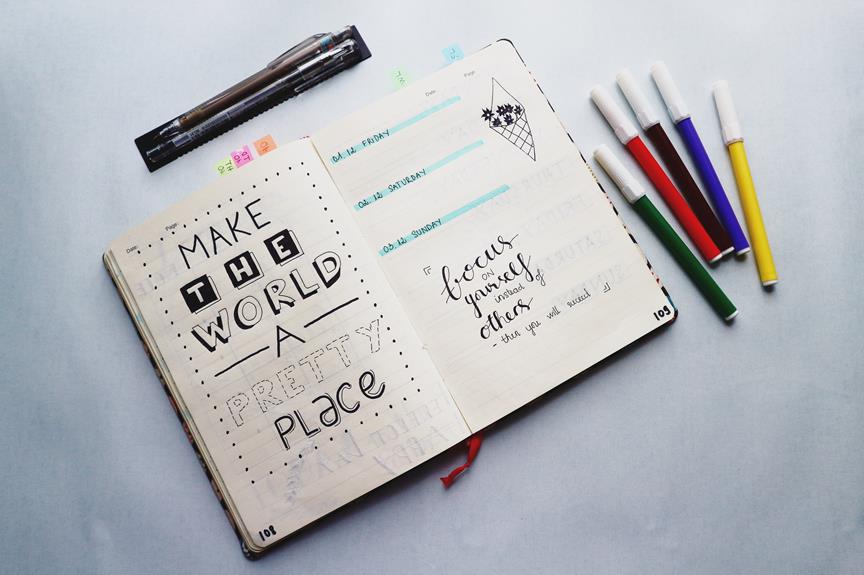Looking to take control of your life and stay organized? Wondering how to start a bullet journal that actually works for you? Well, you've come to the right place! In this article, we'll explore effective ways to begin your bullet journal journey. From setting up the perfect layout to choosing the right supplies, we'll guide you through the process step by step. So grab your pen and get ready to take charge of your life with a bullet journal!
Key Takeaways
- Gather necessary supplies: notebook, pens, markers, ruler
- Choose layout: monthly, weekly, or daily spread
- Create a key and index system for easy reference
- Incorporate habit trackers and goal setting to track progress and stay motivated
Setting up Your Bullet Journal
How can you efficiently set up your bullet journal? To start, gather all the necessary supplies: a notebook, pens, markers, and a ruler. Choose a layout that suits your needs, whether it's a monthly, weekly, or daily spread. Number the pages and create an index at the front for easy reference. Divide your journal into sections for different categories such as goals, tasks, and notes. Use color coding or symbols to categorize and prioritize your entries. Create a future log to keep track of upcoming events and a habit tracker to monitor your progress. Set up a key to make sense of your symbols and abbreviations. Finally, personalize your journal with quotes, stickers, or doodles to make it uniquely yours. With these steps, you can take control of your bullet journal and stay organized.
Choosing the Right Supplies
To efficiently set up your bullet journal, begin by selecting the right supplies. This step is crucial in ensuring that you have the tools needed to take control of your journaling experience. Here are four essential supplies to consider:
- A high-quality notebook: Look for one with thick, bleed-resistant paper that can handle different types of pens and markers. This will give you the freedom to experiment with various writing and drawing techniques.
- Pens and markers: Invest in a set of reliable pens and markers that won't smudge or fade easily. This will allow you to create neat and vibrant layouts.
- Rulers and stencils: These tools will help you achieve clean lines and precise shapes in your bullet journal. They provide the structure and organization that many control-oriented individuals desire.
- Sticky notes and washi tape: These decorative elements can add a touch of personality and creativity to your bullet journal. They allow you to personalize your pages and make them more visually appealing.
Designing Your Key and Index System
Once you have chosen the right supplies for your bullet journal, it's important to design a key and index system to keep track of your entries. This system will help you stay organized and find information quickly. Start by creating a key that uses symbols or colors to represent different tasks or categories. For example, you could use a dot to mark tasks, a star for important events, and an arrow for notes. Make sure to include a legend that explains each symbol. Next, set up an index at the beginning of your journal. Number the pages and write down the corresponding topics or categories. This way, you can easily reference specific information later on. By designing a key and index system, you will have full control over your bullet journal and be able to navigate it with ease.
Creating Monthly and Weekly Spreads
Start by numbering the pages of your bullet journal and creating monthly and weekly spreads to help you plan and organize your tasks and events. This step is crucial in maintaining control over your schedule and ensuring that nothing slips through the cracks. Here are four effective ways to create your monthly and weekly spreads:
- Use color coding: Assign different colors to different categories or types of tasks, making it easier to visually distinguish them at a glance.
- Incorporate habit trackers: Track your daily habits and goals by creating a habit tracker in your weekly spread. This will help you stay accountable and motivated.
- Include a space for notes and reflections: Dedicate a section in your monthly spread for jotting down important thoughts, ideas, and reflections throughout the month.
- Keep it simple: Avoid overcrowding your spreads with unnecessary details. Stick to the essentials to maintain clarity and avoid overwhelming yourself.
Incorporating Habit Trackers and Goal Setting
Incorporate habit trackers and set goals to effectively track your progress and stay motivated in your bullet journal. By including habit trackers, you can keep tabs on your daily routines and activities. This allows you to identify patterns and make adjustments as needed. Set goals that are specific, measurable, attainable, relevant, and time-bound (SMART) to give yourself clear targets to work towards. Write down these goals in your bullet journal and regularly review them to keep yourself focused and accountable. Break down bigger goals into smaller, more manageable tasks to make them less overwhelming. Use your habit trackers to monitor your progress towards your goals and celebrate your achievements along the way. With habit trackers and goal setting, you can take control of your life and make steady progress towards your desires.
